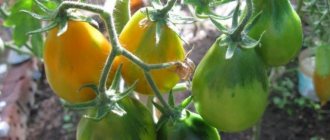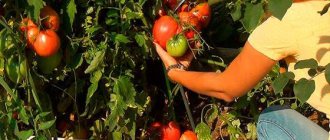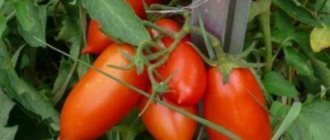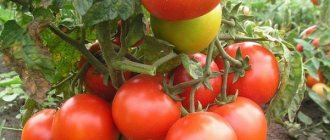The Eagle Heart tomato enjoys constant love among gardeners. Among its highlights that attract gardeners are giant fruits, sugary pink filling, and excellent taste. Not only agricultural masters, but also beginners can handle agricultural technology.
| Height | Landing location | Ripening time | Fruit color | Fruit size | Origin | Fruit shape |
| Tall | Greenhouse, Open ground | Mid-season | Pink | Large | Variety | Heart-shaped |
Description and characteristics of the variety
Ripening time is average - 110-120 days from germination. Fruiting lasts until the onset of autumn days and the first frost.
The Eagle Heart tomato reaches a height of 1.8-2 m. The variety is indeterminate, non-standard.
Characteristics of bushes:
- moderately branched and spreading;
- strong, durable shoots;
- the number of tomatoes in the ovary is 3-4;
- 8-9 fruiting clusters are formed on the bushes;
- on the first lower clusters the fruits reach larger sizes.
What are the characteristics of ripened tomatoes:
- average weight 600-800 g;
- shape, like a heart, with a slightly elongated and pointed tip;
- the largest specimens weigh up to 1 kg;
- the flesh is fleshy, sugary at the break;
- 4-6 seed chambers, few seeds;
- The skin is strong and does not crack.
The taste is bright, rich, with a predominance of sweet notes and moderate tomato sourness.
Advantages and disadvantages
The Eagle's Heart tomato, like many other varieties of tomatoes, has positive and negative sides. The advantages of the variety include the following:
- The fruits ripen at different times, which allows harvesting within 1-2 months.
- The tomato has a high yield, thanks to which it is possible to harvest more than 10 kg of fresh tomatoes per square meter. If you follow agrotechnical rules, the yield can be increased to 15-17 kg.
- Tomatoes are covered with non-cracking skin, which allows them to be transported over long distances.
- The storage period for collected fruits under optimal conditions is 3-4 months.
- Eagle heart is resistant to most common diseases that affect nightshade crops.
- Ripe tomatoes can cope with sudden temperature changes.
See also
Characteristics and description of the Stolypin tomato variety, its yieldRead
The variety has much fewer disadvantages than advantages. The main ones include:
- the need to grow tomatoes only in fertile soils;
- the need for regular pinching and tying up tall bushes.
The disadvantages discussed make it much more difficult for beginners to grow Eagle Heart.
Features of cultivation and storage
Transplanted to a permanent place at the age of 50-60 days. There are no more than 2-3 bushes per 1 m2.
What care nuances should be observed:
- pinching 1 time every 10-12 days;
- forming and maintaining bushes into 2-3 shoots;
- feeding with nutritious organic matter and complex minerals “Agricol”, “Kemira-Universal”;
- moderate watering at the root, 7-8 liters per plant, 2-3 times a week.
The fruits can be picked not completely reddened; they ripen perfectly. Stored for up to 1 month in cool, ventilated areas.
Capacity
Depending on the planned volumes of sowing and other factors, the choice of containers for seedlings is made by each gardener independently according to his preferences and capabilities. The following types of containers are now widely used:
- flowerpots;
- cassette;
- containers;
- egg trays;
- disposable plastic cups;
- peat forms and tablets;
- food packaging and containers;
- boxes made of various materials.
Related article:
If you are planting tomatoes, don’t forget to throw this into the hole...
The main requirement is the presence of a drainage hole at the bottom to drain excess liquid.
Landing in a permanent place
The plant is hardened off 14 days before planting in the garden. To do this, cassettes with seedlings are taken outside or a window is opened in the room with seedlings, starting at short intervals. Gradually it is necessary to increase the duration of exposure to air.
The presence of 6-8 true developed leaves indicates the need for replanting in the ground.
- Dig up the area for the garden bed (you must choose a sunny place), apply organic or complex mineral fertilizers.
- Loosen and prepare holes according to the pattern 50*40 cm.
- Pour water into each of them.
- Plant in a mixture of water and soil.
Related article:
Growing different varieties of tomatoes
For 1 sq. m of beds, 1-2 tomato bushes are planted, other gardeners talk about the possible arrangement of 3-4 stems. This is explained by the height of the plant, the installation of a supporting structure and future garter. The main condition is that the tomatoes do not interfere with each other; this is possible if the following conditions are met:
- Timely removal of excess leaves, shoots and weeds for the purpose of complete aeration.
- Availability of stakes for fixation.
- Garter of bulky tassels.
- Mulching the soil with straw and grass after mowing.
You can also mulch tomatoes with straw or hay.
If there is not enough space for the development of the bush, fruits will be set much smaller than the parameters stated by the originator.
Tomato diseases
The plant most often does not have time to become infected with common diseases and pests, since it is an early ripening plant.
To prevent diseases, the soil is treated with a solution of potassium permanganate before planting.
Diseases
The Tsar's Gift variety affects a number of ailments:
- Fusarium. The cause of the disease is oversaturation of the soil with nitrogen. If tomatoes are infected with fusarium, there is no point in saving the plantings; the affected bushes should be disposed of immediately.
- Root rot. This disease occurs when soil moisture is high. To prevent infection, water tomatoes only when the soil dries out.
- Viral diseases. Diseased plants are removed, since there is no treatment for the disease.
- Necrosis. It occurs due to insufficient illumination of plantings or excessive watering. The disease destroys the surface of the fruit, forming holes. Plantings are treated with phytosporin or a similar drug that prevents the occurrence of fungal diseases.
Pests
Young tomatoes are susceptible to destruction by larvae and insect pests, so the sprouts must be carefully inspected. Most often, the Royal gift amazes:
- Aphid. Get rid of it with a soap solution.
- Spider mite. This insect is small in size and feeds on the sap of leaves. Pests can be seen on the underside of foliage; they usually live in entire colonies. To get rid of the pest, the leaves are wiped with soapy water, dandelion infusion, or irradiated with ultraviolet light.
- Whitefly. It is a larva that feeds on plant sap. Whiteflies are eliminated using insecticides.
- Medvedka. One of the most dangerous pests. She can even get into a greenhouse. The pest lays eggs, from which larvae quickly emerge and feed on the roots of the plant.
Tomato Eagle Heart: reviews, photos, yield
Many gardeners prefer to grow varieties of large-fruited tomatoes. One of them is the Eagle Heart tomato. Pink tomatoes, distinguished by their excellent taste and large fruits, are winning more and more hearts. One tomato is enough for a whole family's salad. The fruits are most often used for these purposes.
Rosy-cheeked tomatoes can be canned, you just need a wide-necked container. And what an amazingly thick and tasty tomato juice comes from Eagle Heart tomatoes! Any housewife will find a use for large and fragrant fruits.
Sowing
Step-by-step recommendations:
- Carefully unfold the gauze with sprouted seeds so as not to damage the fragile sprouts.
- Place 1-2 pieces in each glass; when sowing in common boxes in a furrow, maintain a distance of 2 cm between them.
- Sprinkle with a little soil.
- Spray warm water with a spray bottle.
- Cover with film or glass to create a greenhouse effect inside.
- Place the box in a warm place for germination.
Under no circumstances should containers be placed on the windowsill immediately after sowing - the sprouts under the glass may die!
With the appearance of the first shoots, the plantings are moved to places with constant access to sunlight. For the full growth and development of seedlings, it is necessary to carry out additional illumination with lamps. The air temperature in the room should be +20-22 degrees Celsius.
Related article:
If the tips of the leaves dry out on tomato seedlings
How to grow seedlings
Mid-season tomatoes are grown in seedlings. Seeds are sown 55-65 days before their intended planting in a permanent place.
As a rule, seeds are sown in early May. These terms are suitable for all regions, since in cold cities tomatoes of this variety are grown in a greenhouse.
Seed treatment
Before sowing planting material, the seeds need to be prepared. Many manufacturing companies do this in the factory. If you use seeds from your own harvest or there is no information on dressing on the packaging, then the procedure is carried out at home.
How to prepare seeds for sowing:
- Before use, planting material is sorted. Damaged and darkened seeds are removed.
- The seeds are soaked in salted water prepared from 1 tsp. salt and a glass of water. Those specimens that have sunk to the bottom are suitable for planting.
- Planting material is disinfected. It is soaked in a light pink solution of potassium permanganate or hydrogen peroxide for 20 minutes. Another option is to soak the seeds in aloe juice or soda solution (1 teaspoon of soda per 1 cup of water). After etching, the planting material is washed under running water.
- Growth stimulation. The easiest way to do this is to soak the seeds in one of the following products: Epin, Sodium Humate, Zircon, aloe juice, soda solution. Another option is to keep the seeds in the refrigerator for 3 days before planting, and then keep them for another two days in a piece of cloth moistened with warm water.
A little about containers and soil
Eagle heart is grown both in individual containers and in common boxes.
If you plan to grow a large number of seedlings, it is more convenient to sow the seeds first in one large container (boxes, trays, packaging for cakes and semi-finished products, cut bottles), and then plant the already grown plants in individual pots with a volume of at least 300 ml.
When growing several tomato bushes, it is more advisable to use peat tablets. In this case, seedlings will not need picking.
All containers are treated with a disinfecting solution. They are soaked in boiling water, copper sulfate (0.5 tsp per 2 liters of water) or a dark pink solution of potassium permanganate.
Stores sell special soil for tomatoes and universal soil for seedlings. Both options will do.
There are many recipes for making your own soil mixtures. The most popular option is to combine chernozem and peat in equal proportions, adding 0.5 parts of sand to them. A bucket of such soil is mixed with a glass of ash.
The soil is also disinfected. It is poured with boiling water, copper sulfate or a dark pink solution of potassium permanganate.
Sowing planting material
A layer of soil is poured into the boxes and watered with warm water. Grooves 1 cm deep are made in the soil at a distance of 3 cm. Seeds are placed in them at a distance of 2 cm from each other.
Planting material is sprinkled with earth. Boxes with crops are covered with glass or film and placed in a warm place - for example, near a radiator.
Basic rules of care
Often, novice gardeners are afraid to grow seedlings on their own, preferring to buy tomatoes ready for planting in a permanent place on the market. Quality plants are recognized by their bright green foliage, short internodes, strong stems and stockiness.
When buying seedlings on the market, it is impossible to accurately determine whether the seller is offering the right variety. It is much safer to grow seedlings yourself. Moreover, this is not difficult to do, the main thing is to follow the rules of care:
After all the seeds have germinated, the film is removed. Tomatoes are moved to a cool place for a week. This will prevent them from being pulled out.
Then they are brought into the room. It is important to provide the seedlings with 16 hours of daylight. Experienced gardeners use fluorescent lamps
This reduces the risk of plants being pulled.
Water the plants as the top layer of soil dries. It is important to moisten only the soil so that the liquid does not get on the green tomatoes. Use warm water.
Tomatoes peak during the formation of the third true leaf. Two weeks after this procedure, the plants are fed.
The seedlings are fed three times during the entire growing period with an interval of two weeks. Use special preparations for seedlings (“Strong”, “Solution”) or a product prepared from a bucket of water, 1 kg of chicken manure, 1 tbsp. ash.
10 days before picking for a permanent place, the tomatoes begin to harden, taking them out to the balcony in the warm time of the day.
Seedlings should not be placed in a draft, otherwise the plants will freeze and die. If the plants begin to lose turgor, you should make sure that they are watered correctly.
Planting and care
Seeds are sown throughout March. The soil substrate is selected that is loose and fertile.
Garden light turf is best suited for soil for tomatoes; use 2 parts of it. The following components are added to the soil:
- 1 part compost;
- 1 part peat;
- 1 part sand;
- a glass of ash.
To increase nutritional value, add 20 g of phosphorus-potassium additive per 10 kg. To prevent infection, the mixture is treated:
- 1% potassium permanganate;
- 1% "Fitosporin";
- 1% Bordeaux mixture.
How to sow and care for seedlings:
- placement depth is 2 cm, lightly tamped on top;
- cover with film until germination;
- dive with 2-3 true leaves into 0.5 liter pots;
- hardened at 14-15 degrees;
- additionally illuminated with phytolamps;
- irrigate with warm, settled water from a spray bottle;
- fed with complex formulations “Krepysh” and “Kemira-universal”.
Priming
A popular solution is to purchase a ready-made substrate for sowing seeds for seedlings. Specialized mixtures for tomatoes or universal use are suitable.
In order to save money and control the quality and composition of the soil, many summer residents prepare it themselves:
- Take equal parts of turf, compost, humus and clean river sand.
- Sift all components and remove debris.
- Combine in a deep container, mix thoroughly.
- Fill the seedling containers with drainage and substrate.
- Water with Fitosporin.
- Leave for 1-2 days in a dark place.
- Before sowing, it is good to pour water at room temperature to compact the soil.
Read more about how to prepare soil for seedlings yourself in the article
The variety is most often grown in open ground. For a garden bed, an area where the following previously grew is suitable:
- greenery;
- zucchini;
- carrot;
- cucumbers;
- cauliflower.
Related article:
Tomato Rocket - description and characteristics of an early ripening variety










